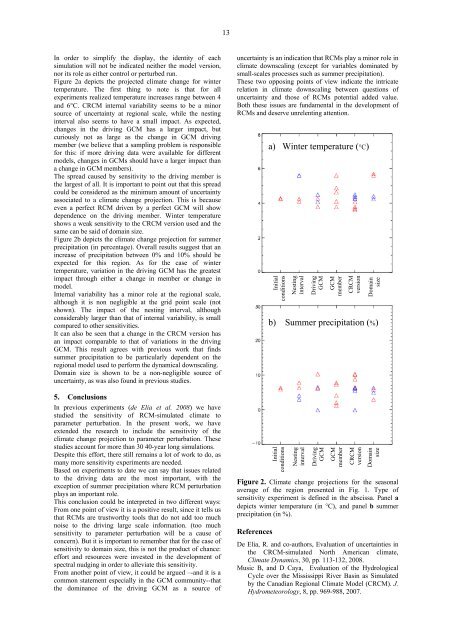Low (web) Quality - BALTEX
Low (web) Quality - BALTEX
Low (web) Quality - BALTEX
Create successful ePaper yourself
Turn your PDF publications into a flip-book with our unique Google optimized e-Paper software.
13<br />
In order to simplify the display, the identity of each<br />
simulation will not be indicated neither the model version,<br />
nor its role as either control or perturbed run.<br />
Figure 2a depicts the projected climate change for winter<br />
temperature. The first thing to note is that for all<br />
experiments realized temperature increases range between 4<br />
and 6°C. CRCM internal variability seems to be a minor<br />
source of uncertainty at regional scale, while the nesting<br />
interval also seems to have a small impact. As expected,<br />
changes in the driving GCM has a larger impact, but<br />
curiously not as large as the change in GCM driving<br />
member (we believe that a sampling problem is responsible<br />
for this: if more driving data were available for different<br />
models, changes in GCMs should have a larger impact than<br />
a change in GCM members).<br />
The spread caused by sensitivity to the driving member is<br />
the largest of all. It is important to point out that this spread<br />
could be considered as the minimum amount of uncertainty<br />
associated to a climate change projection. This is because<br />
even a perfect RCM driven by a perfect GCM will show<br />
dependence on the driving member. Winter temperature<br />
shows a weak sensitivity to the CRCM version used and the<br />
same can be said of domain size.<br />
Figure 2b depicts the climate change projection for summer<br />
precipitation (in percentage). Overall results suggest that an<br />
increase of precipitation between 0% and 10% should be<br />
expected for this region. As for the case of winter<br />
temperature, variation in the driving GCM has the greatest<br />
impact through either a change in member or change in<br />
model.<br />
Internal variability has a minor role at the regional scale,<br />
although it is non negligible at the grid point scale (not<br />
shown). The impact of the nesting interval, although<br />
considerably larger than that of internal variability, is small<br />
compared to other sensitivities.<br />
It can also be seen that a change in the CRCM version has<br />
an impact comparable to that of variations in the driving<br />
GCM. This result agrees with previous work that finds<br />
summer precipitation to be particularly dependent on the<br />
regional model used to perform the dynamical downscaling.<br />
Domain size is shown to be a non-negligible source of<br />
uncertainty, as was also found in previous studies.<br />
5. Conclusions<br />
In previous experiments (de Elia et al. 2008) we have<br />
studied the sensitivity of RCM-simulated climate to<br />
parameter perturbation. In the present work, we have<br />
extended the research to include the sensitivity of the<br />
climate change projection to parameter perturbation. These<br />
studies account for more than 30 40-year long simulations.<br />
Despite this effort, there still remains a lot of work to do, as<br />
many more sensitivity experiments are needed.<br />
Based on experiments to date we can say that issues related<br />
to the driving data are the most important, with the<br />
exception of summer precipitation where RCM perturbation<br />
plays an important role.<br />
This conclusion could be interpreted in two different ways:<br />
From one point of view it is a positive result, since it tells us<br />
that RCMs are trustworthy tools that do not add too much<br />
noise to the driving large scale information. (too much<br />
sensitivity to parameter perturbation will be a cause of<br />
concern). But it is important to remember that for the case of<br />
sensitivity to domain size, this is not the product of chance:<br />
effort and resources were invested in the development of<br />
spectral nudging in order to alleviate this sensitivity.<br />
From another point of view, it could be argued –-and it is a<br />
common statement especially in the GCM community--that<br />
the dominance of the driving GCM as a source of<br />
uncertainty is an indication that RCMs play a minor role in<br />
climate downscaling (except for variables dominated by<br />
small-scales processes such as summer precipitation).<br />
These two opposing points of view indicate the intricate<br />
relation in climate downscaling between questions of<br />
uncertainty and those of RCMs potential added value.<br />
Both these issues are fundamental in the development of<br />
RCMs and deserve unrelenting attention.<br />
Figure 2. Climate change projections for the seasonal<br />
average of the region presented in Fig. 1. Type of<br />
sensitivity experiment is defined in the abscissa. Panel a<br />
depicts winter temperature (in °C), and panel b summer<br />
precipitation (in %).<br />
References<br />
a) Winter temperature (°C)<br />
Initial<br />
conditions<br />
Nesting<br />
interval<br />
Driving<br />
GCM<br />
GCM<br />
member<br />
CRCM<br />
version<br />
Domain<br />
size<br />
b) Summer precipitation (%)<br />
Initial<br />
conditions<br />
Nesting<br />
interval<br />
Driving<br />
GCM<br />
GCM<br />
member<br />
CRCM<br />
version<br />
Domain<br />
size<br />
De Elia, R. and co-authors, Evaluation of uncertainties in<br />
the CRCM-simulated North American climate,<br />
Climate Dynamics, 30, pp. 113-132, 2008.<br />
Music B, and D Caya, Evaluation of the Hydrological<br />
Cycle over the Mississippi River Basin as Simulated<br />
by the Canadian Regional Climate Model (CRCM). J.<br />
Hydrometeorology, 8, pp. 969-988, 2007.













